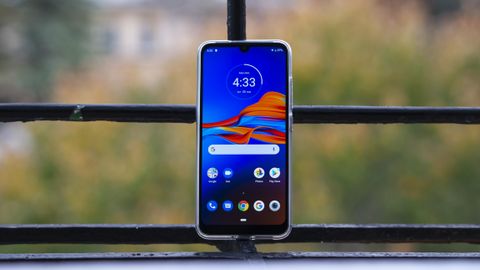Why you can trust TechRadar
Interface and reliability
- A near-stock version of Android 9 Pie
- Bugs and slow app loads
At this price point, the majority of the smartphone competition for the likes of the Moto E6 Plus have their origins in the Far East.
Though this doesn't have many implications for the kind of hardware used, it certainly does for software. For the likes of Xiaomi and Huawei, there's no better version of Android than the one they make themselves.
In essence, this means that they like to tinker and tweak with the operating system, leaving the end result bloated and confused, full of solutions to non-existent problems.

Luckily, Motorola takes the opposite tack. Its version of Android is stripped back and smooth, free of unnecessary clutter. There are no duplicate apps, and no stutters or blips.
One point worth mentioning is the navigation system, which is now entirely gesture-based. Gone is the traditional three button layout, instead swipes are the name of the game. Getting used to this new system takes time, but it is worthwhile - however it isn't really a choice as there's no way of going back.
Apps are positioned on the main screen, with a Google Now screen positioned to be accessed with a left swipe. There's also an app drawer, which is accessed with an upward swipe, and this also displays recently used apps.
Though the interface is smooth, we did experience bugs with unfortunate frequency. This was mainly apps force closing, either from a lack of available memory or otherwise.
Loading apps takes a while too. This is one area where the 2GB of RAM in our unit really makes its presence known. This is a main trade-off for the price point, however the included 32GB of storage space means that apps at least have the room to install.
Movies, music and gaming
- Basic specs mean this isn't great for gaming
- The screen is reasonable for videos
- Includes a headphone jack
With a big screen and solid battery life, the Moto E6 Plus is well positioned to be a reliable companion for content on the go.

For watching TV on the bus it certainly ticks the right boxes - the screen doesn't have any fancy certifications, but it gets the job done.
For games however, the situation is a little different. The basic chipset coupled with the paltry RAM allowance (of 2GB in our handset - though some regions will be getting a 4GB version) means that more challenging titles will be impossible to run. If your mobile gaming habits veer on the side of Angry Birds however, you'll be fine.
Audiophiles won't be inspired by the performance of the headphone jack, however its mere existence at this point is a cause for celebration. The generous allocation of storage (32GB) too means plenty of space for Spotify downloads.
Performance and benchmarks
- Poor performance for anything but the basics
- About what you should expect for the money
With a relatively modern chipset, our hopes for the performance of the Moto E6 Plus weren’t astronomically high, but we were holding out for the potential of something worth writing home about.

Unfortunately, these hopes were dashed - the device costs under £100 and it shows. In day-to-day use, the interface is smooth to navigate, but even remotely intense applications are hamstrung by the lack of power available. This is exacerbated again by the lack of RAM, 2GB simply isn’t enough breathing room for modern Android.
A variant of the device exists which has 4GB of RAM and 64GB of storage (which won’t be making its way to the west), and one does wonder if it might have been better to meet a halfway point between the two and produce a unit with 3GB of RAM.
Regardless, in Geekbench the device achieved a single-core score of 819 and a multi-core score of 3,586. This doesn’t set the charts alight, however it is ahead of the multi-core scores achieved by the Xiaomi Redmi 7A.
In all, this is a device which will fit the needs of most power-wise, provided that expectations are matched to the price point. It won’t overly disappoint; however it also won’t impress.
Current page: Anything else I should know?
Prev Page Battery life and camera Next Page Verdict and competitionSean is a Scottish technology journalist who's written for the likes of T3, Trusted Reviews, TechAdvisor and Expert Reviews.

